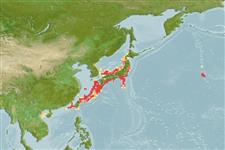Asteroidea |
Forcipulatida |
Asteriidae
Environment: milieu / climate zone / djupintervall / distribution range
Ekologi
; djupintervall 192 - 595 m (Ref. 81020). Subtropical
Northwest Pacific: Taiwan, East China Sea and Japan.
Length at first maturity / Size / Weight / Age
Könsmognad: Lm ? range ? - ? cm
Life cycle and mating behavior
Könsmognad | Reproduktion | Lek | Eggs | Fecundity | Larvae
Members of the class Asteroidea exhibit both asexual (regeneration and clonal) and sexual (gonochoric) means of reproduction. Life cycle: Embryos hatch into planktonic larvae and later metamorphose into pentamorous juveniles which develop into young sea stars with stubby arms.
Chao, S.-M. 2000 New records of sea stars (Asteroidea: Echinodermata) from the continental shelf of Taiwan. Zoological Studies 39(3):275-284. (Ref. 77937)
IUCN Red List Status
(Ref. 130435: Version 2025-1)
CITES status (Ref. 108899)
Not Evaluated
Not Evaluated
Threat to humans
Harmless
Human uses
| FishSource |
Verktyg
Ytterligare information
Trophic EcologyFood items (preys)
Födosammansättning
Födointag
Predatorer
Population dynamicsTillväxt
Max. ages / sizes
Length-weight rel.
Length-length rel.
Length-frequencies
Mass conversion
Abundans
PhysiologySyreförbrukning
Human RelatedStamps, coins, misc.
Internet-källor
Estimates based on models
Preferred temperature
(Ref.
115969): 0.8 - 17.3, mean 11.2 (based on 38 cells).
